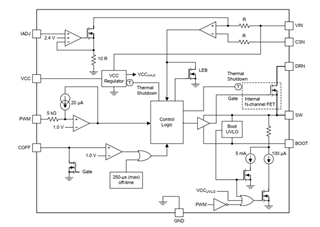Other Parts Discussed in Thread: TPS92515HV-Q1,
Hi,
1. What is the difference between TPS92515AHV-Q1 and TPS92515HV-Q1? How does this part of function TPS92515HV-Q1 realize?
There is an explanation about the difference between the two in the E2E forum. The post describes that the TPS92515AHV-Q1 cancels the function of the offset calibration circuit. If this is the case, what is the function of this part of the circuit, and which part does it belong to in the figure below?

2. What kind of impact will the cancellation of this part of the function have on the circuit? Will it cause abnormal output current accuracy? Customers find that the output cross current accuracy of the two is different. The output cross current accuracy of TPS92515HV-Q1 is 4.58%, while the output cross current accuracy of TPS92515AHV-Q1 is 7.08%.
3. If TPS92515AHV-Q1 uses an external circuit for calibration, what is the calibration method, how to set the external circuit, and is there a circuit for reference?
4. Is it feasible for customers to directly replace TPS92515HV-Q1 with TPS92515AHV-Q1?

